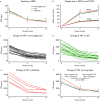The Reduction of Visceral Adipose Tissue after Roux-en-Y Gastric Bypass Is more Pronounced in Patients with Impaired Glucose Metabolism
- PMID: 30109666
- PMCID: PMC6223744
- DOI: 10.1007/s11695-018-3455-x
The Reduction of Visceral Adipose Tissue after Roux-en-Y Gastric Bypass Is more Pronounced in Patients with Impaired Glucose Metabolism
Abstract
Purpose: Visceral adipose tissue (VAT) is associated with cardiometabolic risk factors and insulin resistance. The physiological mechanisms underlying the benefits of Roux-en-Y gastric bypass surgery (RYGB) on glucose metabolism remain incompletely understood. The impact of RYGB on VAT was assessed among three groups of patients stratified by their glucose tolerance before surgery.
Methods: Forty-four obese women were categorized into normoglycemia (n = 21), impaired glucose tolerance (IGT, n = 18) and diabetes (n = 5) before surgery. Body composition measured by dual-energy X-ray absorptiometry (DXA) was performed before surgery, 6 months and 12 months after.
Results: The three groups had comparable mean age (mean 38.6 ± SD 9.9) and BMI at baseline (41.9 ± 4.3 kg/m2). After 12 months, total weight loss (mean 35.1% ± 7.5) and excess weight loss (91.1% ± 25.1) were similar between groups. Pre-surgery mean VAT was significantly higher in diabetes (mean 2495 ± 616 g) than in normoglycemia (1750 ± 617 g, p = 0.02). The percentage of VAT to total body fat was significantly higher in diabetes (mean 4.4% ± 0.9) compared to normoglycemia (2.9% ± 0.8, p = 0.003). Twelve months after surgery, VAT loss was significantly greater among patients with diabetes (mean 1927 ± 413 g) compared to normoglycemia (1202 ± 450, p = 0.009).
Conclusions: RYGB leads to important VAT loss, and this loss is greater in patients with diabetes prior to surgery. As VAT is associated with insulin resistance, this reduction may account for the profound impact of this surgery on glucose metabolism.
Keywords: Bariatric surgery; Dual-energy X-ray absorptiometry (DXA); Roux-en-Y gastric bypass; Type 2 diabetes; Visceral adipose tissue.
Conflict of interest statement
Conflict of Interest Statement
L.F., L.M., A.R., J.A., D.H., N.D., N.P., M.S., T.H.C. declare that they have no conflict of interest.
Statement of Informed Consent
Informed consent was obtained from all individual participants included in the study.
Ethical Approval
All procedures performed in this study were in accordance with the ethical standards of the institutional research committee and with the 1964 Helsinki declaration and its later amendments. The study was approved by the local institutional review board.
Figures

Similar articles
-
Effects of Roux-en-Y gastric bypass or diabetes support and education on insulin sensitivity and insulin secretion in morbidly obese patients with type 2 diabetes.Ann Surg. 2014 Mar;259(3):494-501. doi: 10.1097/SLA.0b013e318294d19c. Ann Surg. 2014. PMID: 23732262 Free PMC article. Clinical Trial.
-
The Effects of Sleeve Gastrectomy and Gastric Bypass on Branched-Chain Amino Acid Metabolism 1 Year After Bariatric Surgery.Obes Surg. 2016 Aug;26(8):1830-5. doi: 10.1007/s11695-015-2023-x. Obes Surg. 2016. PMID: 26729279
-
Comparative Effects of Medical Versus Surgical Weight Loss on Body Composition: a Pilot Randomized Trial.Obes Surg. 2019 Aug;29(8):2503-2510. doi: 10.1007/s11695-019-03879-4. Obes Surg. 2019. PMID: 30997619 Clinical Trial.
-
Mechanisms of improved glycaemic control after Roux-en-Y gastric bypass.Dan Med J. 2015 Apr;62(4):B5057. Dan Med J. 2015. PMID: 25872541 Review.
-
Endocrine and metabolic response to gastric bypass.Curr Opin Clin Nutr Metab Care. 2009 Sep;12(5):515-21. doi: 10.1097/MCO.0b013e32832e1b14. Curr Opin Clin Nutr Metab Care. 2009. PMID: 19535977 Free PMC article. Review.
Cited by
-
Changes in Lean Tissue Mass, Fat Mass, Biological Parameters and Resting Energy Expenditure over 24 Months Following Sleeve Gastrectomy.Nutrients. 2023 Feb 27;15(5):1201. doi: 10.3390/nu15051201. Nutrients. 2023. PMID: 36904198 Free PMC article.
-
The magnitude and progress of lean body mass, fat-free mass, and skeletal muscle mass loss following bariatric surgery: A systematic review and meta-analysis.Obes Rev. 2022 Jan;23(1):e13370. doi: 10.1111/obr.13370. Epub 2021 Oct 19. Obes Rev. 2022. PMID: 34664391 Free PMC article.
-
Impact of Bariatric Surgery on Adipose Tissue Biology.J Clin Med. 2021 Nov 25;10(23):5516. doi: 10.3390/jcm10235516. J Clin Med. 2021. PMID: 34884217 Free PMC article. Review.
-
Marked weight loss on liraglutide 3.0 mg: Real-life experience of a Swiss cohort with obesity.Obesity (Silver Spring). 2023 Jan;31(1):74-82. doi: 10.1002/oby.23596. Epub 2022 Dec 7. Obesity (Silver Spring). 2023. PMID: 36478514 Free PMC article.
-
Long-term body composition improvement in post-menopausal women following bariatric surgery: a cross-sectional and case-control study.Eur J Endocrinol. 2022 Jan 6;186(2):255-263. doi: 10.1530/EJE-21-0895. Eur J Endocrinol. 2022. PMID: 34879003 Free PMC article.
References
-
- Adams TD, Davidson LE, Litwin SE, Kim J, Kolotkin RL, Nanjee MN, Gutierrez JM, Frogley SJ, Ibele AR, Brinton EA, Hopkins PN, McKinlay R, Simper SC, Hunt SC. Weight and metabolic outcomes 12 years after gastric bypass. N Engl J Med. 2017;377(12):1143–1155. doi: 10.1056/NEJMoa1700459. - DOI - PMC - PubMed
-
- Schauer PR, Bhatt DL, Kirwan JP, Wolski K, Aminian A, Brethauer SA, Navaneethan SD, Singh RP, Pothier CE, Nissen SE, Kashyap SR, STAMPEDE Investigators Bariatric surgery versus intensive medical therapy for diabetes - 5-year outcomes. N Engl J Med. 2017;376(7):641–651. doi: 10.1056/NEJMoa1600869. - DOI - PMC - PubMed
-
- Mingrone G, Panunzi S, De Gaetano A, Guidone C, Iaconelli A, Nanni G, et al. Bariatric–metabolic surgery versus conventional medical treatment in obese patients with type 2 diabetes: 5 year follow-up of an open-label, single-centre, randomised controlled trial. Lancet. 2015;386(9997):964–973. doi: 10.1016/S0140-6736(15)00075-6. - DOI - PubMed
Publication types
MeSH terms
Substances
LinkOut - more resources
Full Text Sources
Other Literature Sources
Medical
Research Materials

